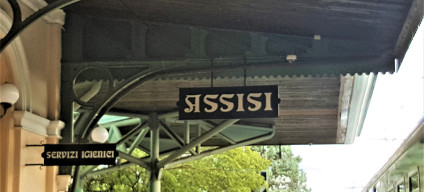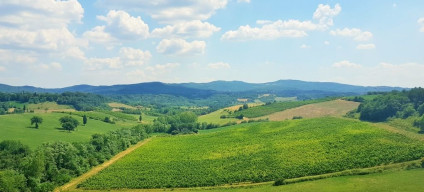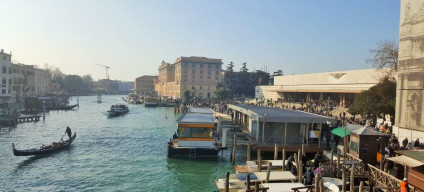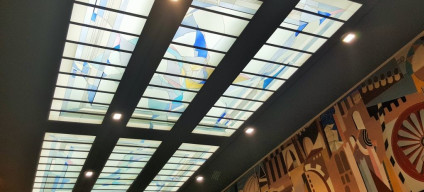Related Content
Content

Italy by train
Italy has some fantastic trains, amazing stations and incredible rail journeys, so this guide will show to how to make the most of exploring Italy by train.
It will help you to save time and money and avoid confusion, click the links below for instant access for the info you need.
Share
Links to Useful Info
11 Things Most Worth Knowing
These are the eleven things that are particularly useful to know about Italian rail travel:
- Trenitalia is the main national rail operator in Italy and it's three key train services are the Frecce trains, the Intercity trains and two types of Regionale sevices.
- Italy has two high speed rail lines; the first stage of a future Milan <> Venice line has opened between Milan and Brescia, but the main route links Turin - Milan - Bologna - Florence - Rome - Naples - Salerno, though many of the trains which use these routes have their journeys extended to other destinations.
- Italo trains compete with Trenitalia's Frecce trains on these high speed routes, so at the main stations you will see Italo branded ticket machines, ticket desks and lounges.
- The announcements at Italian stations and on board the trains are bi-lingual, but the Italian names of cities are not translated, so Firenze is used instead of Florence, and Venezia is used instead of Venice etc.
- Trenitalia only uses the Italian names of cities on its website, but ItaliaRail is an alternative booking service which translates the city names.
- The names of the main stations in Italian cities aren't typically called 'Centrale' - so Milano Centrale and Napoli Centrale are actually the exception.
- Seat reservations are complimentary, so are included when booking tickets to travel on the Frecce, Intercity and Italo trains, but they are not available when travelling on the Regionale trains.
- Purchase a last minute ticket at the station, to travel on an Intercity train and you can't then use it to travel by a Frecce train, similarly if you purchase the cheapest ticket(s) at a station booking office, you can only travel on the Regionale services.
- Tickets which can be used to travel by the Regionale services need to be stamped / validated in a machine prior to boarding, but no other ticket(s) need to be stamped.
- Trenitalia branded ticket machines have good English translation and they enable easy comparison of prices to travel by the different types of train service - they also sell rail pass reservations.
- It's a good idea to look up train times because few routes taken by Regionale trains have regular timetables, there tend to be fewer trains from major cities before 10:00 and after 20:00.
The most scenic Italian rail journeys:
The train is very often the way to go in Italy thanks to easy access from one stunningly beautiful location to another, but thanks to the length of the coastline and the mountainous areas, often the journeys themselves are wonderful.
Of the routes that SMTJ has been fortunate to travel along, our favorite Italian journeys are:
- Salerno <> Reggio Calabria
- Brennero <> Verona
- Genova <> La Spezia
- (Milano) - Lecco <> Tirano
- Domodossola <> Locarno (The Centovali Railway)
- Messina <> Taormina
- (Milano) > Arona > Domodossola > The Simplon Tunnel
- Rimini <> Bari
- Genova <> Ventimiglia
- Messina <> Palermo
Though we have yet to travel on these routes:
- Ventimiglia > Cuneo > Torino
- Torino <> Aosta
- Bolzano <> Merano
- Taranto <> Reggio di Calabria
- Siracusa <> Gela
- Fortezza <> San Candido
Videos captured on Italian travels have been added to the ShowMeTheJourney channel on YouTube.
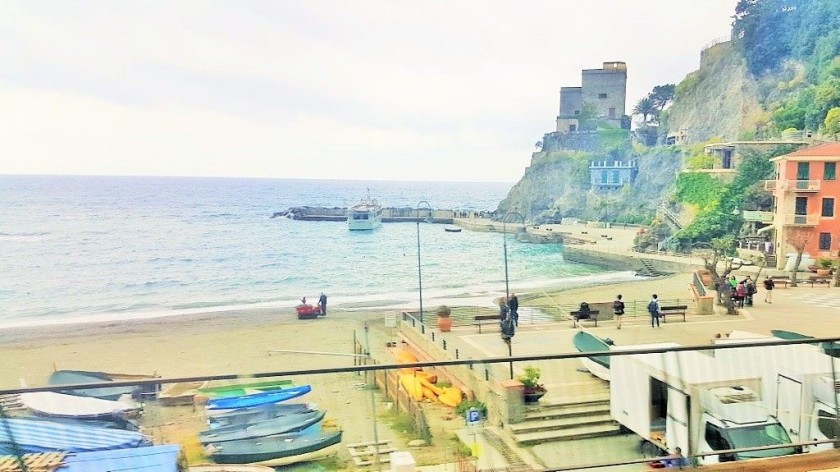







Holidays in Italy by Train
Discover even more useful info and inspiring ideas.
Journeys from Milano/Milan
The journey guides include access to booking links and information about the trains, tickets and destination stations. Plus for the scenic routes there are insights on how to make the most of the rides on the trains.
Journeys from Roma / Rome
The journey guides include access to booking links and information about the trains, tickets and destination stations. Plus for the scenic routes there are insights on how to make the most of the rides on the trains.
Journeys from Venezia / Venice
Notes on the ticketing:
Good to know about Italian rail tickets:
1: Discounted tickets which include seat reservations are available for travel on the express trains.
2. The full price tickets are the 'Base' tickets - and these can be refunded if you subsequently change your travel plans.
3. Trenitalia manages a constant series of promotions, such as two adults travelling on its high speed trains at weekends for the price of one - so take note of these prior to booking.
4. But you don't have to book Italian rail tickets with Trenitalia, the ItaliaRail service is designed around visitors to Italy, also the Austrian national rail company, OBB also sells Italian rail tickets.
5. The Trenitalia, ItaliaRail and OBB websites do not sell tickets for the Italo trains, which compete with Trenitalia's Frecce trains on the high speed routes - and in turn, the Italo website only sells tickets for its trains.
6. Though the Trainline and Omio booking sites enable comparison between Trenitalia's Frecce trains and Italo trains; trains which compete with the Frecce services on the high speed lines.
7. Tickets for the local/regional trains are not discounted, so cost the same when making a last minute purchase at the station.
8. The Trenitalia ticket machines have excellent English translation and are comparatively easy to use.
9. Tickets have to be stamped in machines before boarding Regionale REG/RGV trains – but not when boarding express trains.
10. Tickets for journeys by Frecce trains are now typically made available online up to 6 months ahead of the travel date.
11. Tickets for journeys by Intercity trains are typically made available online up to 4 months ahead of the travel date.
12. Tickets for journeys by the InterCity Notte night trains can be placed on sale between 3 and 4 months ahead of the travel date.
13. These booking windows can be shorter when searching for journeys for travel after the second Sunday in December (all routes and trains) - and for journeys by the IC trains, this also apply to some routes when travelling after the second Sunday in June.
Timetables are updated on both of these days and tickets can't be placed on sale until the new schedules are confirmed.
14. The Trenitalia website, the ItaliaRail website and the OBB website also sell tickets for international trains to/from Italy, but only for journeys by direct trains.
15. Journeys to and from Italy with connections can be booked on Trainline and Rail Europe.
Though if you are new to Italian rail travel, checking out the tips and info on the full guide below is recommended.
Amongst other things you can discover:
- Money saving tips,
- How to book and use child tickets
- The steps to take when using the Trenitalia website
- Why it matters which type of train you will be travelling by.
And the notes further along the Content Menu explain more about these types of train service.
The detailed guide to rail tickets
Using rail passes:
There are multiple types of rail pass which can make it easier and cheaper to explore Italy by train.
- the relatively new Trenitalia Pass,
- one country Eurail and Interrail Passes for Italy,
- Italia in Tour Passes.
Among other nuggets of info, the full guide below explains;
- The train services you can easily hop on and off,
- Which train services require rail pass users to make reservations.
- How to book these reservations - at the cheapest possible price.
Notes on Italian trains:
Travelling on Italian trains has its quirks, particularly if you want to travel at the cheapest possible price, but it can also be a magical experience; a feast for those who appreciate great design and/or travelling through stunning landscapes.
Italy has a primary high speed railway line that runs down the middle of the country on a Torino / Turin – Milano – Bologna – Firenze / Florence – Rome / Roma – Napoli / Naples – Salerno route.
A new high speed line has also opened between Milano and Brescia (the first stage of a Milano – Venezia high speed railway).
Multi-lingual announcements are made on the majority of trains, though the list of stations, which a train will be calling at, always switches back to Italian.
More information about how to board and use these trains is available on the Italian Trains guide.
The train operators:
Not all trains in Italy are operated by the national train operator, Trenitalia; the five main exceptions are;
(1) The Italo services - which offer an alternative to travelling by Trentalia's high speed Frecce services.
Tickets for journeys by Italo services are not sold on the Trenitalia website and similarly tickets for the Frecce services are not available on the Italo website.
The Italo services share stations with Trenitalia's trains but they have separate facilities; ticket machines, info desks, business lounges etc.
(2) Many of the local/regional trains in northern Italy, including those in Lombardy, as well many local/regional trains to/from Milano are operated by Trenord.
(3) The trains between Napoli/Naples and Sorrento.
(4) Many of the local trains in south east Italy including most of those from/to Bari and Lecce.
(5) Some of the local trains in South Tyrol on routes around Bolzano and Brennero.
A choice of train services:
What is comparatively unusual about train travel in Italy is the high likelihood of being able to choose between different train services when taking a journey.
If you will be travelling between towns and cities during the day there can be a choice of up to four different Trenitalia train services, from slowest to fastest they are;
(1) Regionale
(2) Regionale Veloce
(3) Intercity
(4) Frecce
So if you are happy to plan in advance and book ahead, then there are big savings to be made by booking in advance online for the express trains; the Frecce and Intercity trains, which are operated by Trenitalia, OR the Italo trains operated by NTV.
Or if you would rather be spontaneous and buy tickets last minute at the station, you'll pay the same price as you would online if you take the Regionale or Regionale Veloce train services.
Going long-distance by day:
If you will be travelling long-distance you can also usually choose between travelling on the high speed Frecce trains and Italo trains, OR the slower Intercity trains, which still take the parallel, conventional older lines.
So will often have a choice between:
(1) faster, more frequent, but more expensive trains, OR
(2) slower, less frequent, but cheaper trains.
Intercity (IC) trains are slower (and generally cheaper) than Frecce trains because they're conventional express trains and very rarely use the high speed lines.
But because they don't take the high speed lines, a journey by Intercity trains can be more scenic.
Going long-distance by night:
Trenitalia operates 'Treno Notte' overnight trains on these routes; the ↔ symbol indicates which part of the journey is overnight:
(1) Roma ↔ Trento - Bolzano
(2) Roma ↔ Venezia/Venice - Treviso - Udine - Trieste
(3) Roma - Napoli ↔ Messina - Palermo and Siracusa
(4) Torino - Genova - La Spezia - Pisa - Livorno ↔ Messina - Palermo and Siracusa
(5) Milano - Bologna - Firenze ↔ Messina - Palermo and Siracusa
(6) Torino - Milano ↔ Napoli - Salerno
(7) Torino - Milano - Bologna - Firenze - Roma ↔ Villa San Giovanni - Reggio di Calabria
(8) Torino and Milano - Piacenza - Parma - Modena - Bologna - Rimini ↔ Bari - Lecce
More information is available on our Italian Trains guide.
The high speed (AV) services:




All of the train services which use the high speed lines for all OR part of their journey are designated as AV services
AV services are operated by Trenitalia
the Frecciarossa 1000
the Frecciarossa 700
the Frecciarossa 500 and
the Frecciargento
in effect compete with Italo trains operated by NTV.
Many AV services also have their journeys extended to more distant destinations not served by the high speed lines.
You won't be travelling on a high speed line if you take an AV service between these destinations:
- Venezia/Venice and Brescia
- Venezia/Venice and Bologna
- Bolzano and Bologna
- Salerno and Regio di Calabria
- Lecce and Bologna via Bari and Rimini.
Trains also have to divert off the high speed lines in order to call at the main stations in Milano, Florence/Firenze, Roma and Napoli; meaning that the trains which stick to the direct route are faster.
Choosing between the high speed AV trains:
If you want to make a high speed journey, you can nearly always choose between a Frecce train service operated by Trenitalia, or an Italo train service operated by NTV.
Trenitalia uses four types of Frecce train on the high speed lines – Frecciarossa 1000, Frecciarossa 500, Frecciarossa 700 and Frecciargento trains.
On some routes there is a choice between different types of Frecce trains.
The journey times will be similar and it won't affect the ticket prices either, but the on-board ambiences can be different, particularly in the premium classes.
If you will be travelling in the premium classes and have a choice between travelling by a Frecciarossa 1000 train or a Frecciargento train; ShowMeTheJourney's recommendation is to take the Frecciarossa 1000 train.
On the Italo trains, the Frecciarossa 1000 trains and the Frecciarossa 500 trains, you can choose between travelling in four classes of accommodation.
Also worth knowing is that Trenitalia's Frecciabianca trains are given AV train numbers, but they don’t travel on the high speed line (usually).
On board the AV trains:
On your ticket the 'carrozza' number is the coach/car number and the 'posti' is the seat number
As all seats are reserved on Frecce and Italo services, the stations between which seat is reserved is not indicated on the trains.
You will only need to look for the seat number(s).
When boarding, if you want to change seats ask the conductor first; don't assume that a spare seat will be available for your entire journey.
If you prefer to face forwards, note that all trains reverse direction when they call at Firenze S.M.N., Milano Centrale, Napoli Centrale, Roma Termini and Venezia S. Lucia.
The local and regional trains:
Regionale Veloce (RV) and Regionale (R) are similar, but different train services.
Regionale (R) trains are predominantly local trains, while Regionale Veloce (RV) trains link towns and cities over longer distances and skip some stations.
So when travelling between larger towns, Regionale Veloce (RV) trains CAN be faster, but tickets cost the same price as the slower as Regionale (R) trains.
So look for RV/RGV trains heading to your destination on the departure screens.
Many destinations in Italy most popular with tourists are only served by these trains; on which you can't save money by booking in advance.
Though Italia in Tour Passes are available for 3 or 5 days of unlimited travel by the R and RV trains operated by Trenitalia.
Bicycles:
Standard (non-folding) bicycles, which haven't been disassembled, can only be taken on board the Regionale and Regionale Veloce trains - bike tickets are required.
More info is available here.








Detailed train guides
Click on the buttons below to access info such as on board facilities, and what to look out for when boarding and travelling with luggage/bikes.
Good to know about the main stations:
Italian stations are bi-lingual, all signage is in English and Italian and ticket machines have excellent English translation.
At major stations the announcements re: train departures are in Italian and English; the English announcements always follow the Italian announcements.
However, Italian place names aren’t translated into English, Florence is always Firenze etc
More information is available on our Italian Stations guide.
Many Italian cities, including Genova, Firenze, Milano, Roma and Venezia, have more than one station that long distance express trains call at; and the names of these stations are often more fanciful than logical.
So when planning a journey, booking a ticket or before boarding a train, try to work out which station suits you best for accessing your final destination.
Trains reverse direction when calling at these main city centre stations, when on route to other destinations - Firenze S.M.N., Milano Centrale, Napoli Centrale and Roma Termini.
Buying tickets at a main station:
The type of train you will be travelling by matters when booking tickets at the station.
Because tickets for the Regionale and Regionale Veloce trains are cheaper they CAN'T be used to travel on Intercity or Frecce trains.
So once you have booked the ticket(s) valid for the Regionale trains, you can't just hop on any next train to your destination.
If the next train to leave isn't one of the two Regionale services, you will have to hang back and wait until a Regionale or Regionale Veloce train service will be departing.
Similarly tickets booked at the station for Intercity trains can't then be used to travel by Frecce trains.
The Italo trains:
Italo trains have their own ticket desks and branded ticket machines.
Trenitalia branded ticket counters and machines don’t sell tickets for Italo trains and vice versa.
Using the ticket machines:
Trenitalia's ticket machines can be a good alternative to the queues that can build up at the ticket office.
They have excellent English translations and are comparatively easy to use, though watch out for the fact that some machines are cash only, others are card only and some are both.
When there is a choice of different train services, and therefore different tickets prices, these options are clearly shown on the machines.
The departure times, arrival time and journey time are shown, so you can work out which train will get you to your destination faster - and decide if the time saving is worth the extra cost.
Also be aware that only journeys by Trenitalia trains WITHIN Italy can be purchased from the machines.
Finding your train:
Each individual train service has a unique 4-digit 'TRENO' number that is preceded on departure screens with an abbreviation of the type of train service - AV, IC, RGV or REG.
These train numbers are used on the departure information at stations - and if you have booked a ticket for a specific Frecce or Intercity departure, then this TRENO (train) number will be printed on your ticket.
The easiest means of working out the specific departure details of your train can be matching the train number on your ticket with the train number on the information screens.
At major stations red electronic screens are being installed along the length of the platforms/binari that are used by the Frecce and Intercity and Italo trains.
Around 5-10 mins before departure, these screens will display the numbers of the carrozza/coach, which will be located beside each screen when the train arrives.
So use them to know where to wait on the binario/platform for ease of boarding into the carrozza/coach in which your assigned seat is located; match the number on the screen to the carrozza number on your ticket.
When these screens aren’t available it can be best to wait in the middle of the platform and then make a dash towards the coach that your seat is located in – but don’t delay, if need be, board the train by the nearest door and walk through to find your seat.
More information, including how to make sense of the departure screens is available on the guide to using Italian stations.
Left luggage:
Italian stations don't have left luggage lockers, instead some* of the larger stations have staffed left luggage offices.
*Stations with no left luggage facilities include Torino Porta Susa, Messina Centrale, Roma Tiburtina, Modena, Brindisi, Lecce, SanRemo and Milano Porta Garibaldi.
You hand your bags to the staff and then pay in advance when depositing your bags - pay attention to the opening times, you will only be able to return and retrieve your luggage when the office is open.
If you subsequently leave your bag for longer than planned, you can pay the balance when you collect it.
However, be aware that because you will receive a personal service, long queues can build up at busy times at the popular stations - we have waited more than 45 mins to deposit bags at Venezia S. Lucia and Firenze S.M.N. stations.
The queues tend to move quicker when collecting rather than depositing, but be at the station a minimum of 30 mins before your train leaves, if you have bags to retrieve.
Trenitalia has also partnered with company to provide Stow Your Bags luggage storage facilities at locations away from the station in multiple cities - some of which, including Brescia, Catania and Siena, don't have in station left luggage facilities.
Detailed station guides
Click the buttons below to discover how to travel to and from the stations by public transport, plus links to additional info including the station and city websites.
International rail routes to and from Italy:
Search for a journey:
Pan-European train travel guides
This second version of ShowMeTheJourney is exciting and new, so we are genuinely thrilled that you are here and reading this, but we also need your help.
We’re striving not to let anything get in the way of providing the most useful service possible, hence a facility has been set up with DonorBox which can be used to support the running costs and make improvements.
Instead of advertising or paywalls, your financial support will make a positive difference to delivering an enhanced service, as there’s a lot of ideas which we want to make happen.
So if you have found the info provided here to be useful, please consider saying thank you.
See if there’s a unique journey guide for your trip, featuring info on the trains, tickets & stations.

This is one of more than 100 train travel guides available on ShowMeTheJourney, which will make it easier to take the train journeys you want or need to make. As always, all images were captured on trips taken by ShowMeTheJourney.












